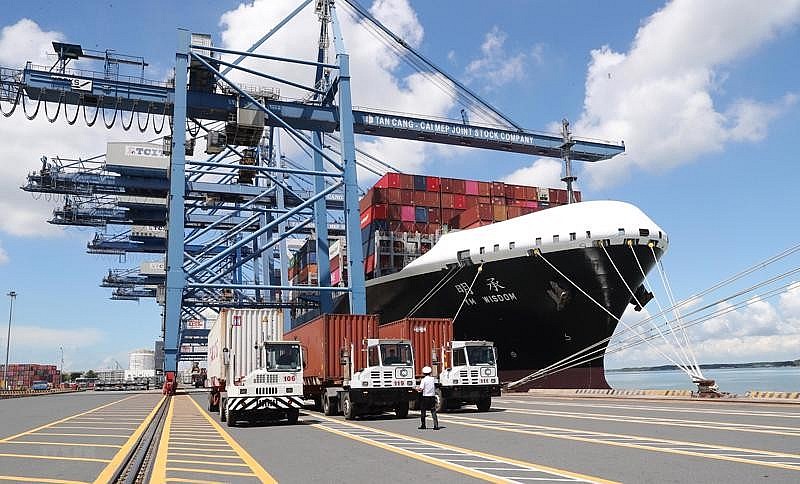 News
News
According to statistics from the General Department of Customs , Vietnam's exports to Canada in the first four months of 2023 reached US$1,687 billion, down 17.1% over the same period in 2022 (the decline rate was lower than in previous months. ). However, according to the host country's data published on May 23, 2023, only by the end of March 2023, Vietnam had exported 2.187 billion USD.
 |
| Canada is Vietnam's 5th most important export market |
This marked difference is because Canada includes the transshipment flow of imports through the United States into Canada. If calculated according to the data of the host country, Canada is the 5th most important export market of Vietnam (after the United States, China, Korea, Japan).
However, the growth rate recorded in the host country data shows that Vietnam's exports have not been affected and will be less affected by the economic situation in Canada. Electronics, electrical appliances, reactors, boilers, optical equipment, automobiles and spare parts continued to record good growth.
From the beginning of the year until now, the Top 10 commodity groups that account for the largest proportion of Vietnam's export turnover to Canada have maintained a double-digit growth rate (except for seafood, which decreased by 32.8%; furniture decreased by 32.8%). 8.1% and toys and sporting goods down 4%): electronics, mobile phones by 28.9%; footwear increased by 82.8%; knitted clothing by 12.4%; non-knitted clothing increased by 29.8%; boiler reactors increased by 16.7%; leather products by 75.7%; optical equipment increased by 14.2%.
However, some other important export items of Vietnam have started to record decline such as nuts and seeds down 39.5%; plastic products down 16.6%; rubber and rubber products down 4.4%; iron and steel fell 77.8%; iron and steel products down 4.5%; aluminum products down 27.7%; ceramic products decreased by 15.2% over the same period last year.
The growth rate of Vietnam's exports to Canada in the first three months of 2023 is much higher than the growth rate of Canada's imports from countries around the world (9.3%) and higher than all other countries. Major exporters in ASEAN such as Indonesia, Malaysia, Thailand….
In the Top 10 of Canada's top trading partners, Vietnam recorded the first export growth rate but dropped to the 8th position as an export partner.
The import trend of the Canadian market also clearly shows the "friendshoring" orientation in Canada's foreign strategy, whereby Canada continues to prioritize imports from allied partners (with a sudden growth from Germany) , Italy, the UK, an average of 10% or more) and a sharp decrease in imports from China (down 10.1% over the same period in 2022).
In addition to major export barriers for Vietnam, such as high domestic logistics costs in Canada, Vietnam's export prices are less competitive compared to neighboring South American countries; low Canadian dollar (CAD) exchange rate policy; social and environmental criteria; packaging standards and recycled plastic content, etc., the trend of Canada promoting policies towards the South American economic bloc is a trend that has a clear impact on the export of a number of Vietnam's strengths, such as fruit. , aquatic products, textiles.
According to the Vietnam Trade Office in Canada , in the first quarter of 2023, through tracking the host country's data, Canada especially boosted imports from Ecuador, Argentina, Chile and Mexico. With the exception of Argentina, both Ecuador, Chile and Mexico have new-generation Free Trade Agreements (FTAs) bilaterally with Canada.
Research on local data from 2018 to 2022 shows that, since the CPTPP took effect, Vietnam's exports in most fields of agricultural products and processed foods have increased (except for fruit and vegetable products). seed).
In the field of consumer goods, many products of the domestic industrial sector had a remarkable increase, demonstrating the positive impact of the CPTPP on Vietnam's exports to the region.
However, Vietnam's rate of using preferential tariffs under CPTPP has not yet fully exploited the potential that this Agreement brings.
According to host country data, in 2022, about 81% of Vietnam's exports to Canada still use MFN tariff preferences and less than 1% still use GPT preferences; only 18% use CPTPP tariff preferences.
The reason is that Vietnamese enterprises are not interested in using the CPTPP tariff preferences ; or because our products are not qualified in terms of origin/regional content (usually for textile products because CPTPP requires origin from yarn onwards).
In addition, in many fields of products, exporters and importers still do not know how to take advantage and exploit the principle of cumulative origin in production, in the strategy of purchasing input materials to ensure high quality. CPTPP in origin to enjoy preferential tariffs. "This can be said to be the most unfortunate limitation, hindering Vietnam's export potential to this market ," said the Vietnam Trade Office in Canada.